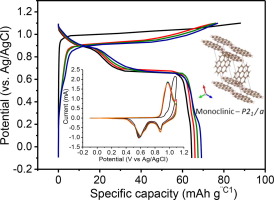Electrochemistry Communications ( IF 4.7 ) Pub Date : 2019-11-06 , DOI: 10.1016/j.elecom.2019.106599 Ismael A. Rodríguez-Pérez , Lu Zhang , Daniel P. Leonard , Xiulei Ji

|
We report coronene, a polycyclic aromatic hydrocarbon (PAH), exhibits reversible oxidative anion insertion properties in a LiTFSI based water-in-salt electrolyte. The coronene electrode delivers a reversible capacity of ∼65 mAh g–1 with the first-cycle Coulombic efficiency of ∼73%. The results demonstrate that the high concentrations of LiTFSI lower the anion-insertion potential in coronene, which allows to reveal the capacity below the onset of oxygen evolution reaction. Furthermore, evidence points to the polymerization of the coronene cathode surface, which contributes to the reversible anion-storage in coronene as well. Ex situ XRD, FTIR, and SEM are carried out to reveal the structural evolution of the coronene electrode and storage mechanism of the TFSI– anions. FTIR studies reveal that upon anion insertion the interactions between the TFSI– ion and coronene molecules resemble that of covalent bonding.
中文翻译:

通过盐包水电解质将阴离子水插入碳氢化合物阴极
我们报告说,多环芳烃(PAH)冠冕烯在基于LiTFSI的盐包水电解质中表现出可逆的氧化阴离子插入特性。ron电极的可逆容量约为65 mAh g –1,第一循环库仑效率约为73%。结果表明,高浓度的LiTFSI降低了日冕中阴离子的插入电势,从而揭示了低于析氧反应开始时的容量。此外,有证据表明,ron烯阴极表面发生了聚合反应,这也有助于将可逆的阴离子存储在ron烯中。通过异位XRD,FTIR和SEM揭示了co烯电极的结构演变和TFSI的存储机理–阴离子。FTIR研究表明,插入阴离子后,TFSI –离子与环氧乙烷分子之间的相互作用类似于共价键的相互作用。











































 京公网安备 11010802027423号
京公网安备 11010802027423号